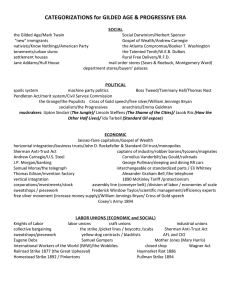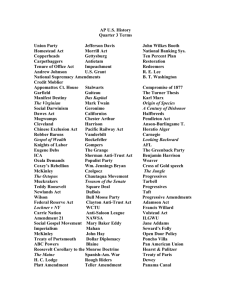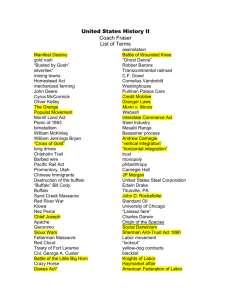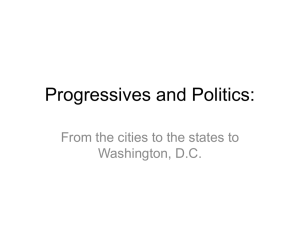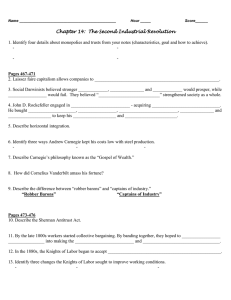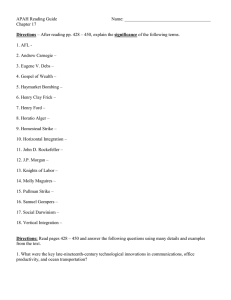Invention, Industry, Immigration, and Progressive Change
advertisement
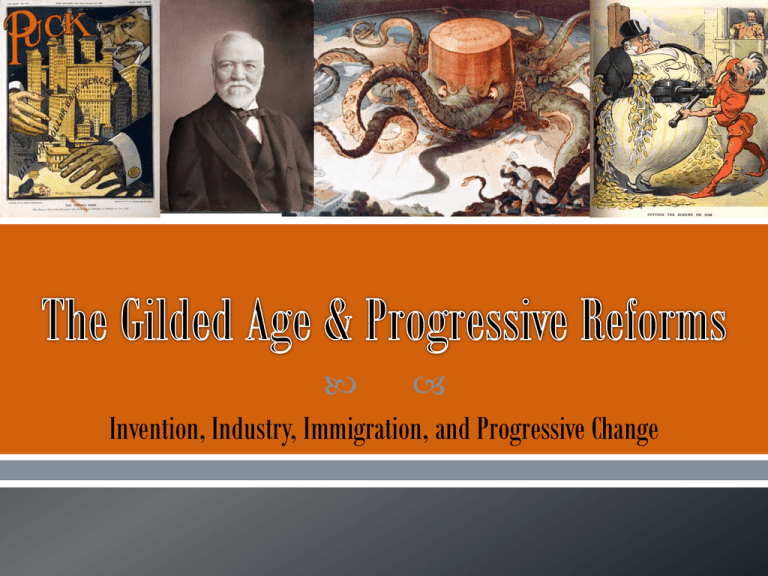
Invention, Industry, Immigration, and Progressive Change Ambrose Bierce defined corporations as “ingenious devices for obtaining individual profit without individual responsibility.” Corporations allow shareholders to own a portion of a company, profit from it when it makes money. (You can also lose your money if the corporation is mismanaged.) What corporations do very effectively is limit risk – by allowing you to own part of a company without putting your entire life savings at risk – and limit liability. Smithfield Foods is pumping filth and pollution into the James River? Cruelty to the little piggy? Not my problem! Even if you are a shareholder, you’re not to blame – at least not legally. Thomas Edison, known as the “Wizard of Menlo Park,” held thousands of patents by the end of his career as an inventor. Among the most important were the light bulb, the battery cell, the motion picture machine, and the electric generator. Not all of the ideas were his own, but his patents gave him lucrative opportunities in business. Alexander Graham Bell was the inventor of the telephone. “Mr. Watson, come here, I want you!” was the first line every conveyed by telephone. Bell would go on to become the founder of the American Telephone and Telegraph Company, or AT&T. By the turn of the century, telephone communication was common. The First Flight took place in Kitty Hawk, North Carolina on December 17th, 1903. The Wright Brothers were bicycle mechanics by trade, but put all of their efforts into the airplane during the off season. Their invention would change the nature of travel in America, and even the nature of warfare. By World War I – in 1914 – the airplane was used to gain strategic advantages on the battlefield. The automobile was not invented in the United States, it was a product of Europe. And even in the United States, there were several men who began producing automobiles before Henry Ford came along – The Duryea Brothers and Ransom Olds, for example. Henry Ford’s genius was the invention of the assembly line as a way to mass produce his Model-T Ford. Henry Ford’s Model-T Ford was mass produced using the assembly line. He joked that it came in “any color you like, as long as it’s black.” Henry Bessemer was an Englishman who invented a process to purify iron ore into steel. By blasting the molten iron ore with pure oxygen, the Bessemer Process purified the iron, allowing it to form steel, a metal strong enough to build railroads and bridges, as well as the I-beams used in the construction of skyscrapers. Andrew Carnegie was the man who dominated the steel industry in the United States between the Civil War and the turn of the Century in 1900. Carnegie got started as a businessman during the Civil War, and controlled over 80 percent of the Steel Industry by the 1890s. He used “vertical integration” to cut the cost of his steel, and sold his company in 1901 for over $400 Million. He spent the rest of his life giving his money away to charitable causes. John Pierpont Morgan was the leader of the banking and financial institutions of the United States during the late 1800s and early 1900s. He was so influential that when banks slumped in the early part of the1900s, he bailed them out personally! No TARP or Stimulus Package required! Morgan was involved in numerous anti-competitive trusts. Several of his companies were sued for violation of the Sherman Anti-Trust Act. John D. Rockefeller was the leader of the Standard Oil Trust, which controlled the oil refineries of the United States during the late 19th Century. His company refined kerosene until the invention of the light bulb, and began refining motor oil and gasoline once the automobile became more popular. Eventually, the Standard Oil Trust was sued for violating the Sherman Anti-Trust Act, broken apart, and destroyed. Cornelius Vanderbilt controlled most of the railroads in the United States east of the Mississippi River during the 19th Century. He had consolidated all of the railroads in New York, and made his fortune by controlling trade by rails in the states. He was involved in numerous trusts and pools, and accumulated hundreds of millions of dollars. Laissez-Faire economic policies are those that leave free markets alone! The government does not regulate businesses at all – and in the case of the US government, it promoted some companies with tax breaks and land. From the French expression meaning “hands off,” the term laissez-faire refers to economic policies in which the government choices not to regulate our capitalist economy. By allowing free markets to do as they will, the government endorsed the free market. In the late 19th Century, though, the government did more than that! The government actively promoted certain companies, especially railroads, by granting tax exemptions and land to the companies that built the rails. One of the most important characteristics of the United States which encouraged the development of our economy was the abundance of natural resources: Coal Mining Water Timber Iron Ore Oil During the last half of the 19th Century, millions of immigrants flooded into the United States. Most came to the United States poor and looking for work. A reliable source of cheap labor was good for big business. Big business grew rapidly because there was a reliable source of cheap labor: immigrants. The expression “The Gilded Age” was coined by Mark Twain and describes the character of the late 1800s. On the surface, there were many wealthy industrialists doing quite well; however, just beneath the surface there were many more poor people, struggling and suffering. All labor unions were unified in hoping to correct these major problems for workers: Low Pay Child Labor Dangerous Working Conditions Long Hours No Job Security No Benefits Labor Unions like the Knights of Labor, the American Federation of Labor, the American Railway Union, and the Industrial Workers of the World all favored the 8hour day and sought safer working conditions for employees. The goals of labor unions were many, but the most important were: The 8 Hour Day Safer Working Conditions High Pay Ending Child Labor Worker’s Compensation Greater Job Security As America’s first national labor union, the Knights of Labor played an important role in setting the goals of working people. They accepted all members – black or white, men or women, skilled or unskilled – and their major goals were the eight hour day and higher pay. In 1886, an anarchist lobbed a bomb into a crowd of striking workers from the McCormick Harvesting Company. They were participating in a strike led by the Knights of Labor. The bomb killed several police officers and ruined the reputation of the Knights of Labor. They would forever be associated with violence and radicalism. Eventually the union lost all influence. Violence at the Haymarket Square Riot caused the Knights of Labor to lose their influence. Americans associated the group with the violence and radicalism which took place at Haymarket Square in Chicago, IL. Established by Samuel Gompers in 1886, the American Federation of Labor was a union which attempted to take the place of the Knights of Labor. They only accepted skilled workers into the union, and they sought two major goals. First, they wanted an 8-hour working day. Secondly, they wanted for workers at companies to engage in collective bargaining. This way, they could negotiate for high wages more effectively. Samuel Gompers disliked calling strikes as a general rule, but the AFL would be involved in some of the most bitter labor strikes in history. When Andrew Carnegie attempted to slash the wages of all of his employees in 1892, the workers walked out on strike. When the Homestead Plant attempted to bring in strikebreakers to replace the workers, violence erupted. After several bloody clashes, the Pennsylvania State militia began shooting the striking workers. The union lost the strike, and many of the men were blacklisted – never to be hired again by major industries, which feared labor agitators. One of the most important labor unions in American history was the American Railway Union, led by the Socialist activist Eugene V. Debs. The American Railway Union organized all of the men who loaded, unloaded, and operated trains all across the United States. During the Pullman Strike, they refused to work on trains which carried Pullman cars – causing a huge blockage of the nation’s railways in 1894. In 1894, a small strike of employees at Pullman Palace Car Company – a company town – blew up into a much larger affair. When George Pullman slashed wages, but left the price of rent and consumer goods available at the company store at the same rates, workers walked out. Then, to support the small company’s workers, Eugene V. Debs – leader of the American Railway Union, ordered a sympathy strike. His men refused to load or unload any trains with Pullman cars attached. Eventually, President Grover Cleveland used the Army to force the men back to work. The strike ended in failure. Eugene V. Debs ordered his men to support the striking workers of the Pullman Palace Car Company. After several weeks when the US Postal Service could not deliver the mail, President Grover Cleveland sent in the US Army and ordered the men back to work. At one point, this labor union was one of the largest in the United States. After the horrifying Triangle Shirtwaist Fire of 1911, the union work towards laws enforcing fire codes and better safety conditions for working people. Although a few of the women who led the union leaned towards radicalism, most were simply seeking better pay and a safe workplace. Over 140 young immigrant women were burned alive – or jumped to a gruesome death – during the Triangle Shirtwaist Fire of 1911. After the fire, the International Ladies Garment Worker Union fought for better safety conditions and fire codes inspected by city officials. Progressives of the 19th Century wanted more democracy, or reforms that would give Americans more control over who was elected to office and what they were allowed to do. Progressives believe in economic opportunity – supporting the causes of labor union for higher pay and supporting Anti-Trust laws to protect consumers. Progressives wanted to eliminate social injustices for women, the poor, immigrants and African-Americans. They were less successful with these goals. Cleaning up local governments was a goal of some progressives, including Thomas Nast, the cartoonist who criticized political machines like the Tammany Ring in New York City. Progressives encouraged commission systems and city managers instead of the old corrupt political machines governments were so corrupt during the late which succeeded in electing mayors Local th Century and early 20th, that many Progressives 19 and councilmen who took bribes and sought to end the traditional system of mayors and kickbacks. city councilmen. The “Commission System” and the hiring of city managers were two possible solutions. Most Progressives supported reforms that would give voters on the state level greater power to control their localities. Robert La Follette of Wisconsin was one of the most important leaders, seeking: Referendums Initiatives Recall Elections The Primary System Secret Ballots The 17th Amendment Muckrakers opposed child labor because they felt that children who were forced to work were underpaid and robbed of their youths. Union opposed child labor because they were underpaid. Progressives like Florence Kelley opposed child labor because she felt that all children were entitled to education. She and individuals like Horace Mann encouraged compulsory education bills, requiring the children attend school! Woman’s groups like the National American Woman’s Suffrage Association demanded the right to vote. Following in the footsteps of leaders like Elizabeth Cady Stanton and Susan B. Anthony, women like Mary Chapman Catt succeeded in the ratification of the 19th Amendment, which gave women the right to vote in national elections in 1919. By passing the Sherman Anti-Trust Act in 1890 and the Clayton AntiTrust Act in 1914, Progressive Reformers attempted to create a fairer economic system – one that considered the needs of laborers and consumers as much as it did the barons of industry. Progressive Presidents like Theodore Roosevelt and William Howard Taft used the Sherman Anti-Trust Act to sue companies engaged in anti-competitive and unfair practices like monopolies, trusts, and pools. The law was used to destroy the Meat Trust, railroad pools like the Northern Securities Trust, and eventually the Standard Oil Company. Theodore Roosevelt was committed to a Square Deal for all – meaning that he was committed to these goals: 1. 2. 3. 4. Conservation of Natural Resources – so that future generations would benefit from the resources of the nation and the environment would be preserved. Control of Corporations – so that no anticompetitive practices were allowed to stand, which would hurt consumers and small businesses. Consumer Protection – like the Meat Inspection Act and the Pure Food and Drug Act. Fair Play for Workers – Roosevelt was the first President to side with working people during a labor dispute – the Anthracite Coal Strike of 1902. In his four years in office from 1909 – 1913, William Howard Taft sued more companies for violations of the Sherman AntiTrust Act that Theodore Roosevelt had in seven years! In 1912, the two men could not resolve their differences, however, and ran against one another – and Woodrow Wilson – for the Presidency. Both men lost… Woodrow Wilson believed that the government should destroy trusts, but not favor any one business over another. He advocated for the Clayton Anti-Trust Act which was much stricter than the Sherman Anti-Trust Act had been. He helped to create the Federal Trade Commission and the Federal Reserve in order to place controls on the banking industry. In addition, he lowered “protective” tariffs, to lower prices for consumers. New Freedom? It was less Freedom for big business and monopolies! The Clayton Anti-Trust Act was passed in 1914 to strengthen the Sherman Anti-Trust Act. The Clayton Anti-Trust law made so unions could not be prosecuted by antitrust lawsuits – the Sherman Anti-Trust Act had been misapplied at times. Woodrow Wilson also attempted to regulate the Banking and Financial Industry during this period. The Federal Reserve Act placed controls on the banking and financial industries
